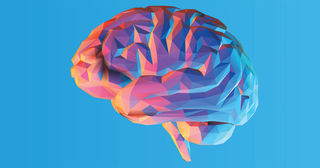Personality
The Physical Evolution of Consciousness
How did matter come to perceive, think, and know itself?
Posted July 22, 2018
The brain is a physical organ—that much is clear to everyone. But how do we understand the mind and consciousness—what is it and how did it evolve?

Do you think of yourself as having a brain or being a brain? Can you conceive of your mind, your personality, your self, as entirely and only the product of your physical brain? The mind seems non-physical, ethereal and spiritual. The intuitive sense that mind and brain are separate entities can be hard to shake. But, what we know from science is that the mind comes from the brain and nothing but the brain. The mind is what the brain does. Any theory that does not begin with this assumption would necessarily imply that practically all the rest of modern science is fundamentally incorrect.
The physical basis of consciousness is a guiding principle behind a great many practical and effective treatments for mental illnesses. Daily, I witness the subtle or dramatic effects of varying degrees of disturbance of brain functioning on the ‘mind’ or ‘personality.’ I also witness the beneficial cognitive, emotional, and behavioral effects of physically based medical treatments1. There is no aspect of the mind, the personality, the ‘self,’ or the ‘will’ that is not completely susceptible to chemical influences or physical diseases that disrupt neuronal circuitry.
If you have ever had someone close to you suffer from gradually progressive dementia, serious head injury, or a variety of other forms of brain damage or serious mental disorder, then you have witnessed the disruption or a kind of ‘disassembly’ of the mind—and of the person or personality you once knew. Such a change highlights how the mind is entirely a product of the physical brain and is dependent on intact neural circuitry.
The mystery of consciousness may eventually be solved—like the mystery of life itself
Human consciousness, like the body, is the product of biological evolution. Though science is still at an early stage of a complete and detailed understanding of the evolution of consciousness, a great deal of progress has already been made.
It was not so long ago that the question of what makes a thing alive was just as much of a mystery as consciousness is today. Living things were believed to be imbued with some sort of mysterious animating essence, some kind of vital force (‘élan vital’) that non-living things lacked. Yet, we now understand that both living and non-living things are only composed of atoms. There is no difference in the kinds of atoms—just their relative proportions.
What makes a thing alive is the organization of its atoms.
Why humans are a ‘dynamic network of information’
Whatever else accounts for consciousness, it is probably an emergent phenomenon—the product of the organization of matter2.
An emergent phenomenon (also simply called emergence) refers to how a complex system acquires properties that differ both quantitatively and qualitatively from its simpler constituents—properties that are not inherent to its constituents and cannot be inferred or predicted from them. The whole is greater than the sum of its parts. There is no ‘magic’ involved here, just complex physical interactions. Emergence is a spontaneous, bottom-up, self-organising phenomenon of complexity, with no external cause required.
A great deal is known about the evolution of nervous systems, from simple organisms all the way up the evolutionary tree to the human brain. And much is now understood about how nervous systems give rise to sensory perception, emotion3, thought process4, and action or behaviour.
For example, the building blocks of learning and memory are molecular mechanisms that are essentially the same in humans as they are in the humble sea snail. Information is physically encoded—embodied, you could say—in structural molecular changes in the neuron. In some ways, the vastly superior power of the human brain is just the result of the complex combinations in which these simple molecular building blocks have been assembled by evolution.
Biological systems have evolved complex genetic control of local processes, but there is no blueprint for the system as a whole—no grand design for a whole organ or whole organism. Elements within the system interact with neighboring elements at a local level according to very simple ‘rules’ or patterns. Complex feedback loops spontaneously arise in the system. The cells that make up a single organism function more like an ant colony than an army—there is no top-down command and control. This is more or less the case for neurons and the brain as a whole.
Science has shown us how all this amazing self-organising complexity can be sculpted by blind natural evolutionary processes, creating an illusion of design. Counterintuitively, these evolutionary processes that lack even a smidgeon of awareness, planning, foresight or caring have produced humans capable of great awareness, planning, foresight and caring.
There are gradations of conscious self-awareness in humans at different levels of early development, in people with different levels of impairment of brain function, and in animals at different levels of evolutionary complexity.5
We are the sum of all our complex, dynamically interconnected brain networks. We are composed of a lifetime of remembered experiences, knowledge, learned behaviors and habits. We are all of that information, physically embodied in the total network’s connections, recursively reflecting on itself in a cybernetic loop. We are organized matter. Information is physical and humans are a dynamic network of information. The sense of self is an elaborate illusion. But it’s a pretty darn awesome illusion.6
1. Conversely, brain scans reveal the physical effects of psychological therapies.
2. More specifically, a product of the interactions and spatiotemporal relationships between particles.
3. Emotions are chemically mediated.
4. Thought process can be physically modelled as computation and representation.
5. Correlating with the degree of neuronal complexity and the degree of functional integrity of the nervous system.
6. For a more in depth understanding of the nature of consciousness and how it evolved, see my five-part blog series: "What Actually Is Consciousness, and How Did It Evolve?" (Part 1 of 5).




